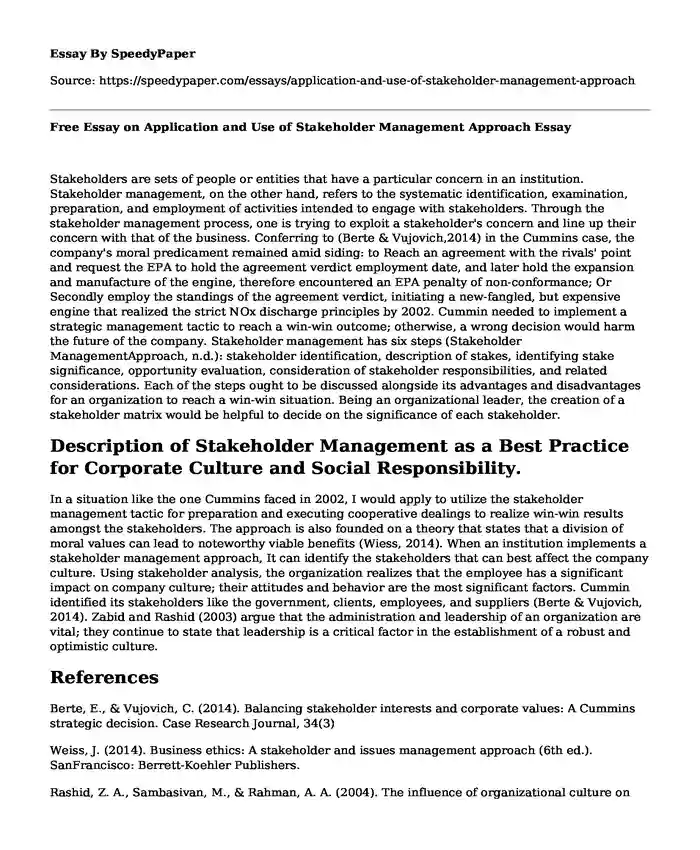
| Type of paper: | Essay |
| Categories: | Business ethics Organizational culture Leadership management |
| Pages: | 2 |
| Wordcount: | 441 words |
Stakeholders are sets of people or entities that have a particular concern in an institution. Stakeholder management, on the other hand, refers to the systematic identification, examination, preparation, and employment of activities intended to engage with stakeholders. Through the stakeholder management process, one is trying to exploit a stakeholder's concern and line up their concern with that of the business. Conferring to (Berte & Vujovich,2014) in the Cummins case, the company's moral predicament remained amid siding: to Reach an agreement with the rivals' point and request the EPA to hold the agreement verdict employment date, and later hold the expansion and manufacture of the engine, therefore encountered an EPA penalty of non-conformance; Or Secondly employ the standings of the agreement verdict, initiating a new-fangled, but expensive engine that realized the strict NOx discharge principles by 2002. Cummin needed to implement a strategic management tactic to reach a win-win outcome; otherwise, a wrong decision would harm the future of the company. Stakeholder management has six steps (Stakeholder ManagementApproach, n.d.): stakeholder identification, description of stakes, identifying stake significance, opportunity evaluation, consideration of stakeholder responsibilities, and related considerations. Each of the steps ought to be discussed alongside its advantages and disadvantages for an organization to reach a win-win situation. Being an organizational leader, the creation of a stakeholder matrix would be helpful to decide on the significance of each stakeholder.
Description of Stakeholder Management as a Best Practice for Corporate Culture and Social Responsibility.
In a situation like the one Cummins faced in 2002, I would apply to utilize the stakeholder management tactic for preparation and executing cooperative dealings to realize win-win results amongst the stakeholders. The approach is also founded on a theory that states that a division of moral values can lead to noteworthy viable benefits (Wiess, 2014). When an institution implements a stakeholder management approach, It can identify the stakeholders that can best affect the company culture. Using stakeholder analysis, the organization realizes that the employee has a significant impact on company culture; their attitudes and behavior are the most significant factors. Cummin identified its stakeholders like the government, clients, employees, and suppliers (Berte & Vujovich, 2014). Zabid and Rashid (2003) argue that the administration and leadership of an organization are vital; they continue to state that leadership is a critical factor in the establishment of a robust and optimistic culture.
References
Berte, E., & Vujovich, C. (2014). Balancing stakeholder interests and corporate values: A Cummins strategic decision. Case Research Journal, 34(3)
Weiss, J. (2014). Business ethics: A stakeholder and issues management approach (6th ed.). SanFrancisco: Berrett-Koehler Publishers.
Rashid, Z. A., Sambasivan, M., & Rahman, A. A. (2004). The influence of organizational culture on attitudes toward organizational change. Leadership & organization development journal.
Cite this page
Free Essay on Application and Use of Stakeholder Management Approach. (2023, Mar 28). Retrieved from https://speedypaper.net/essays/application-and-use-of-stakeholder-management-approach
Request Removal
If you are the original author of this essay and no longer wish to have it published on the SpeedyPaper website, please click below to request its removal:
- Essay Example on Prevention of Medical Error
- Role of Social Media Essay Sample
- What Is Man Flu Essay Sample
- Essay Sample on Colonization and Resistance of Indio-America
- Literary Analysis Essay on From a Sand County Almanac: Sustainability and Conservation
- The Central Bank of Australia (CBA) - Essay Example
- Essay on Impacts, Challenges, and the Future of Operation Supply Chain Management in Agriculture
Popular categories




